
The economic activity represents the whole of the actions that must be carried out by physical or moral persons (called economic agents) in order to satisfy their needs thanks to the production of goods and services.
Economic agents are all in relation with each other. For example, households have relationships with other economic agents such as companies, banks and government agencies, which are themselves in reciprocal relationships. These exchanges are materialized by flows that represent the movement of goods and services (real flows) and the movement of money (monetary flows) between the different economic agents.
The economic circuit is a pictorial and simplified representation of economic activity that allows the essential relationships between the different agents to be described by means of flows. Each flow is characterized by its nature and the direction of movement, represented, by convention, by means of a directed arrow.
The flows are, in general, reciprocal and a real flow, work for example, corresponds, in return, to a monetary flow, the wage.
However, some flows are unilateral and therefore have no counterpart. For example, it may be a real flow that has no monetary counterpart, such as the free service of a public administration or the work of a volunteer for an association. Conversely, a monetary flow may not give rise, in return, to a real flow or a monetary flow: this would be the case, for example, for a donation made by a household to the Red Cross, which is a private administration.
An example of an economic circuit
Source : www.maxicours.com
This scheme includes financial companies, which are essentially banks or credit institutions. They finance economic agents by granting them loans (which will give rise to repayments including interest) and also manage the savings of these economic agents (deposit accounts, purchase of securities, etc.). The rest of the world includes all the economic agents (households, companies or administrations) abroad who have relations with the country.
Administrations are financed by compulsory levies (taxes, duties and social contributions), in return for which they provide free or quasi-free (non-market) services and pay social benefits (redistributed income such as unemployment benefits, scholarships...) and subsidies to companies (financial aid to develop innovation for example).
This representation of economic activity therefore reflects a global vision of economic mechanisms that allows us to understand the interdependencies between economic agents. It is an essential tool for forecasting and economic analysis.
Illustrative example
Let us imagine in this example that the State decides to increase the level of the minimum wage in Benin (SMIG), what will happen?
Thanks to this increase in the minimum wage, households will increase their consumption, which will improve the profits of companies. They will be able to expand, produce more and hire new employees. Households will also save a little more, which will increase the reserves of financial companies, which will then be able to lend more money (to companies that invest, for example).
The government's revenues will increase, and compulsory deductions will be higher because of the increase in income and consumption. The State will therefore be able to devote these new resources to health and education spending or redistribute more income to the poorest.
Finally, some of this additional income will be consumed in foreign products, which will increase imports.
The increase in the minimum wage will therefore have led to an increase in production, consumption and the income of economic agents. There will therefore be economic growth. However, this could lead to a deterioration in Benin's trade balance due to the increase in imports.